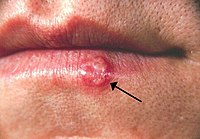
Photo from wikipedia
Abstract Few prospective studies have documented the seropositivity among those children infected with severe acute respiratory syndrome coronavirus 2. From 2 April 2021 to 24 June 2021, we prospectively enrolled… Click to show full abstract
Abstract Few prospective studies have documented the seropositivity among those children infected with severe acute respiratory syndrome coronavirus 2. From 2 April 2021 to 24 June 2021, we prospectively enrolled children between the ages of 2 and 17 years at three North Carolina healthcare systems. Participants received at least four at-home serological tests detecting the presence of antibodies against, but not differentiating between, the nucleocapsid or spike antigen. A total of 1,058 participants were enrolled in the study, completing 2,709 tests between 1 May 2021 and 31 October 2021. Using multilevel regression with poststratification techniques and considering our assay sensitivity and sensitivity, we estimated that the seroprevalence of infection-induced antibodies among unvaccinated children and adolescents aged 2–17 years in North Carolina increased from 15.2% (95% credible interval, CrI 9.0–22.0) in May 2021 to 54.1% (95% CrI 46.7–61.1) by October 2021, indicating an average infection-to-reported-case ratio of 5. A rapid rise in seropositivity was most pronounced in those unvaccinated children aged 12–17 years, based on our estimates. This study underlines the utility of serial, serological testing to inform a broader understanding of the regional immune landscape and spread of infection.
Journal Title: Epidemiology and Infection
Year Published: 2023
Link to full text (if available)
Share on Social Media: Sign Up to like & get
recommendations!